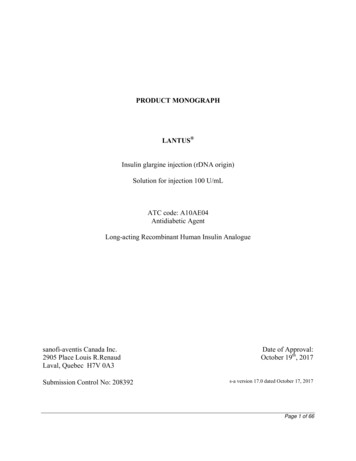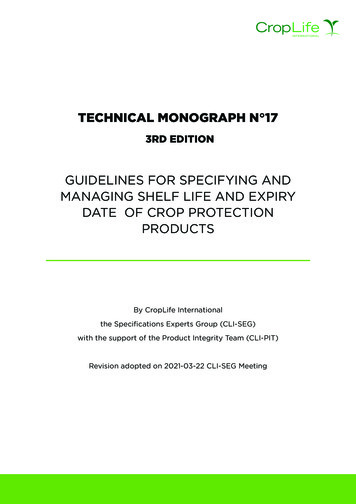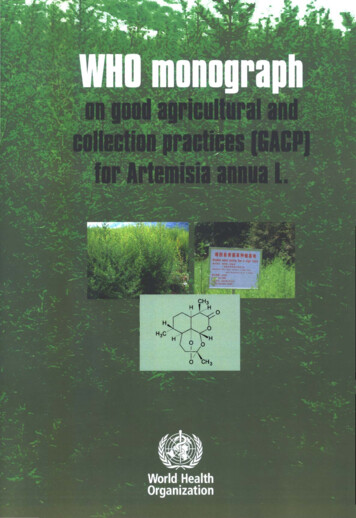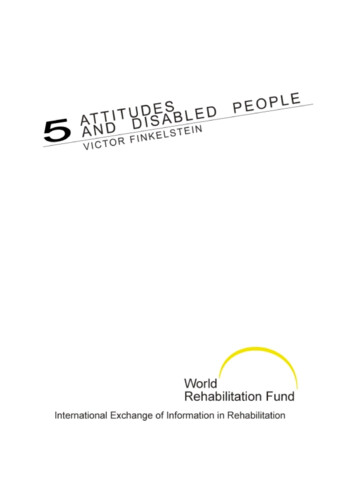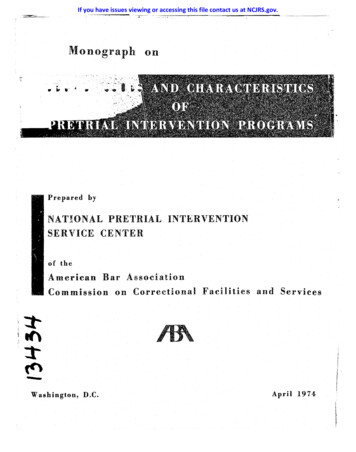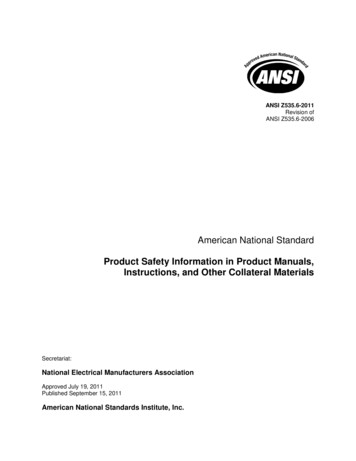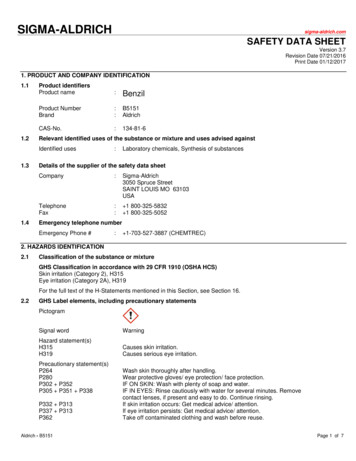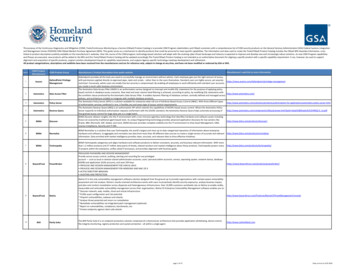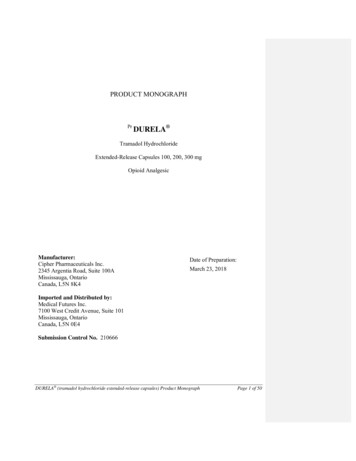
Transcription
PRODUCT MONOGRAPHPrDURELA Tramadol HydrochlorideExtended-Release Capsules 100, 200, 300 mgOpioid AnalgesicManufacturer:Cipher Pharmaceuticals Inc.2345 Argentia Road, Suite 100AMississauga, OntarioCanada, L5N 8K4Date of Preparation:March 23, 2018Imported and Distributed by:Medical Futures Inc.7100 West Credit Avenue, Suite 101Mississauga, OntarioCanada, L5N 0E4Submission Control No. 210666DURELA (tramadol hydrochloride extended-release capsules) Product MonographPage 1 of 50
Table of ContentsPART I: HEALTH PROFESSIONAL INFORMATION . 3SUMMARY PRODUCT INFORMATION . 3INDICATIONS AND CLINICAL USE . 3CONTRAINDICATIONS . 4WARNINGS AND PRECAUTIONS . 4ADVERSE REACTIONS . 17DRUG INTERACTIONS . 21DOSAGE AND ADMINISTRATION . 25OVERDOSAGE . 29ACTION AND CLINICAL PHARMACOLOGY . 29STORAGE AND STABILITY . 35SPECIAL HANDLING INSTRUCTIONS . 35DOSAGE FORMS, COMPOSITION AND PACKAGING . 35PART II: SCIENTIFIC INFORMATION . 36PHARMACEUTICAL INFORMATION . 36CLINICAL TRIALS . 37DETAILED PHARMACOLOGY . 39TOXICOLOGY . 39REFERENCES . 41PART III: PATIENT MEDICATION INFORMATION . 43Formatted: French (Canada)Field Code ChangedFormatted: French (Canada)Formatted: French (Canada)Field Code ChangedFormatted: French (Canada)Formatted: French (Canada)Field Code ChangedFormatted: French (Canada)Field Code ChangedFormatted: French (Canada)Formatted: French (Canada)DURELA (tramadol hydrochloride extended-release capsules) Product MonographPage 2 of 50
PrDURELA Tramadol Hydrochloride Extended-Release Capsules, 100, 200, 300 mgPART I: HEALTH PROFESSIONAL INFORMATIONSUMMARY PRODUCT INFORMATIONRoute ofAdministrationDosage Form /StrengthNonmedicinal Ingredientsoralextended-releasecapsules100, 200, 300 mgcorn starch, D & C Red #7 calcium lake(E180), D & C Yellow #10 aluminum lake,Eudragit NE 30D, FD & C Blue #2 aluminumlake (E132), gelatin, hypromellose, lactosemonohydrate 200 mesh, magnesium stearate,microcrystalline cellulose, polysorbate 80,povidone K30, shellac, simethicone emulsion,sodium starch glycolate, sucrose stearate, talcand titanium dioxideINDICATIONS AND CLINICAL USEDURELA (tramadol HCl extended-release capsules) is indicated for: the management of moderate to moderately severe pain in adults who requirecontinuous treatment for several days or more.Geriatrics ( 65 years of age):In general, dose selection for an elderly patient should be cautious, usually starting at the lowend of the dosing range, reflecting the greater frequency of decreased hepatic, renal, or cardiacfunction, concomitant disease or other drug therapy.Healthy elderly subjects aged 65 to 75 years administered tramadol have plasma concentrationsand elimination half-lives comparable to those observed in healthy subjects less than 65 yearsof age. DURELA should be administered with greater caution in patients older than 75 years,due to the greater potential for adverse events in this population (see WARNINGS ANDPRECAUTIONS, DOSAGE AND ADMINISTRATION).Pediatrics ( 18 years of age):The safety and efficacy of DURELA has not been studied in the pediatric population.Therefore, use of DURELA is not recommended in patients under 18 years of age.DURELA (tramadol hydrochloride extended-release capsules) Product MonographPage 3 of 50
CONTRAINDICATIONS Patients who are hypersensitive to tramadol, or other opioid analgesics, or to anyingredient in the formulation. For a complete listing, see the DOSAGE FORMS,COMPOSITION AND PACKAGING section of the Product MonographIn patients with known or suspected mechanical gastrointestinal obstruction (e.g., bowelobstruction, strictures) or any disease/conditions that affect bowel transit (e.g., ileus ofany type)Patients with suspected surgical abdomen (e.g., acute appendicitis or pancreatitis)In any situation where opioids are contraindicated, including acute intoxication withalcohol, hypnotics, centrally acting analgesics, opioids, or psychotropic drugs. Tramadolmay worsen central nervous system and respiratory depression in these patientsPatients taking monoamine oxidase (MAO) inhibitors (or within 14 days of such therapy)Severe renal or hepatic impairment (creatinine clearance of less than 30 mL/min and/orChild-Pugh Class CPatients with mild, intermittent or short-duration pain that can be managed with otherpain medicationsThe management of peri-operative painPatients with acute or severe bronchial asthma, chronic obstructive airway, or statusasthmaticusPediatric patients less than 18 years of age who have undergone tonsillectomy and/oradenoidectomy for obstructive sleep apnea syndromePediatric patients less than 12 years of ageDo not use DURELA while pregnant, nursing, during labour or deliveryWARNINGS AND PRECAUTIONSSERIOUS WARNINGS AND PRECAUTIONSLimitations of UseBecause of the risks of addiction, abuse, and misuse with opioids, even at recommendeddoses, and because of the greater risks of overdose and death with extended-releaseopioid formulations, DURELA should only be used in patients for whom alternativetreatment options are ineffective or not tolerated (e.g., non-opioid analgesics), or wouldbe otherwise inadequate to provide sufficient management of pain (e.g., immediaterelease opioids) (see DOSAGE AND ADMINISTRATION).Addiction, Abuse, and MisuseDURELA poses risks of opioid addiction, abuse, and misuse, which can lead to overdoseand death. Each patient’s risk should be assessed prior to prescribing DURELA, and allpatients should be monitored regularly for the development of these behaviours orconditions (see WARNINGS AND PRECAUTIONS). DURELA should be storedsecurely to avoid theft or misuse.DURELA (tramadol hydrochloride extended-release capsules) Product MonographPage 4 of 50
Life-threatening Respiratory Depression: OVERDOSESerious, life-threatening, or fatal respiratory depression may occur with use ofDURELA. Infants exposed in-utero or through breast milk are at risk of life-threateningrespiratory depression upon delivery or when nursed. Patients should be monitored forrespiratory depression, especially during initiation of DURELA or following a doseincrease.DURELA must be swallowed whole; crushing, chewing, or dissolving DURELA extendedrelease capsules can cause rapid release and absorption of a potentially fatal dose oftramadol hydrochloride (see WARNINGS AND PRECAUTIONS). Further, instructpatients of the hazards related to taking opioids including fatal overdose.Accidental ExposureAccidental consumption of even one dose of DURELA, especially by children, can resultin a fatal overdose of (tramadol hydrochloride) (see DOSAGE ANDADMINISTRATION Disposal, for instructions on proper disposal).Neonatal Opioid Withdrawal SyndromeProlonged maternal use of DURELA during pregnancy can result in neonatal opioidwithdrawal syndrome, which may be life-threatening (see WARNINGS ANDPRECAUTIONS).Interaction with AlcoholThe co-ingestion of alcohol with DURELA may result in increased plasma levels and apotentially fatal overdose of tramadol hydrochloride (see WARNINGS ANDPRECAUTIONS and DRUG INTERACTIONS).Risks from Concomitant Use With Benzodiazepines Or Other CNS DepressantsConcomitant use of opioids with benzodiazepines or other central nervous system (CNS)depressants, including alcohol, may result in profound sedation, respiratory depression,coma, and death (see WARNINGS AND PRECAUTIONS, Neurologic and DRUGINTERACTIONS). Reserve concomitant prescribing of DURELA and benzodiapines or other CNSdepressants for use in patients for whom alternative options are inadequate. Limit dosages and durations to the minimum required. Follow patients for signs and symptoms of respiratory depression and sedation.DURELA (tramadol hydrochloride extended-release capsules) Product MonographPage 5 of 50
GeneralDURELA must be swallowed whole and should not be broken, chewed, dissolved or crushed,since this can lead to the rapid release of tramadol and absorption of a potentially fatal doseof tramadol.Patients should be instructed not to give DURELA (tramadol hydrochloride) capsules toanyone other than the patient for whom it was prescribed, as such inappropriate use mayhave severe medical consequences, including death. DURELA should be stored securely toavoid theft or misuse.DURELA should only be prescribed by persons knowledgeable in the continuousadministration of potent opioids, in the management of patients receiving potent opioids forthe treatment of pain, and in the detection and management of respiratory depression,including the use of opioid antagonists.Patients should be cautioned not to consume alcohol while taking DURELA as it may increase thechance of experiencing serious adverse events, including death.Hyperalgesia that will not respond to a further dose increase of tramadol hydrochloride can occurat particularly high doses. A tramadol hydrochloride dose reduction or change in opioid may berequired.Seizure RiskSeizures have been reported in patients receiving tramadol within the recommended dosage range.Spontaneous post-marketing reports indicate that seizure risk is increased with doses of tramadolabove the recommended range. Concomitant use of tramadol increases the seizure risk in patientstaking: Selective serotonin re-uptake inhibitors (SSRI antidepressants or anorectics), Tricyclic antidepressants (TCAs), and other tricyclic compounds (e.g., cyclobenzaprine,promethazine, etc.), Opioids.Administration of tramadol may enhance the seizure risk in patients taking: MAO inhibitors (see CONTRAINDICATIONS), Neuroleptics, or Other drugs that reduce the seizure threshold.Risk of convulsions may also increase in patients with epilepsy, those with a history of seizures, orin patients with a recognized risk for seizure (such as head trauma, metabolic disorders, alcoholand drug withdrawal, CNS infections). In tramadol overdose, naloxone administration mayincrease the risk of seizure.DURELA (tramadol hydrochloride extended-release capsules) Product MonographPage 6 of 50
Anaphylactoid ReactionsSerious and rarely fatal anaphylactoid reactions have been reported in patients receiving therapywith tramadol. When these rare reactions do occur it is often following the first dose. Otherreported reactions include pruritus, hives, bronchospasm and angioedema, toxic epidermalnecrolysis and Stevens-Johnson syndrome. Patients with a history of anaphylactoid reactions tocodeine and other opioids may be at increased risk and therefore should not receive tramadol (seeCONTRAINDICATIONS). Patients with acute respiratory depression, elevated carbon dioxide levels in the blood,and cor pulmonale Patients with acute alcoholism, delirium tremens, and convulsive disorders Patients with severe CNS depression, increased cerebrospinal or intracranial pressure,and head injury Women who are breastfeeding, pregnant, or during labour and delivery.Drug Abuse, Addiction, Dependence and MisuseLike all opioids, DURELA is a potential drug of abuse and misuse, which can lead to overdoseand death. Therefore, DURELA should be prescribed and handled with caution.DURELA is intended for oral use only. The tablets should be swallowed whole, and not chewedor crushed. Abuse of oral dosage forms can be expected to result in serious adverse events,including death.Patients should be assessed for their clinical risks for opioid abuse or addiction prior to beingprescribed opioids. All patients receiving opioids should be routinely monitored for signs ofmisuse and abuse. DURELA should not be used in opioid-dependent patients since it cannotsuppress morphine withdrawal symptoms, even though it is an opioid agonist.Opioids, such as DURELA, should be used with particular care in patients with a history ofalcohol and illicit/ prescription drug abuse. However, concerns about abuse, addiction, anddiversion should not prevent the proper management of pain.A Risk Management program to support the safe and effective use of DURELA has beenestablished. The following are considered to be the essential components of the RiskManagement program:a) Commitment to not emphasize or highlight the scheduling status of DURELA (i.e., notlisted under a schedule to the CDSA) in its advertising or promotional activities;b) Inclusion of a PAAB-approved fair balance statement in all DURELA advertising andpromotional materials;c) Assurance that health-care education activities on pain management with DURELAinclude balanced, evidence-based and current information. Commitment to takereasonable actions to inform health-care professionals that there is Health Canadaapproved patient information on benefits and risks, and to ensure that this informationcan be readily accessed through electronic and/or hard copy sources.DURELA (tramadol hydrochloride extended-release capsules) Product MonographPage 7 of 50
Dependence/ToleranceAs with other opioids, tolerance and physical dependence may develop upon repeatedadministration of DURELA and there is a potential for development of psychologicaldependence.Physical dependence and tolerance reflect the neuroadapatation of the opiate receptors tochronic exposure to an opiate, and are separate and distinct from abuse and addiction.Tolerance, as well as physical dependence, may develop upon repeated administration ofopioids, and are not by themselves evidence of an addictive disorder or abuse.Tramadol has a potential to cause psychic and physical dependence of the morphine-type (µopioid). The drug has been associated with craving, drug-seeking behaviour and tolerancedevelopment. Cases of abuse and dependence on tramadol have been reported. DURELAshould not be used in opioid-dependent patients. Tramadol can re-initiate physical dependencein patients who have been previously dependent or chronically using other opioids. In patientswith a tendency to abuse drugs or a history of drug dependence, and in patients who arechronically using opioids, treatment with DURELA is not recommended.Withdrawal SymptomsPatients on prolonged therapy should be tapered gradually from the drug if it is no longerrequired for pain control. Withdrawal symptoms may occur following abrupt discontinuation oftherapy or upon administration of an opioid antagonist. Some of the symptoms that may beassociated with abrupt withdrawal of an opioid analgesic include body aches, diarrhea,gooseflesh, loss of appetite, nausea, nervousness or restlessness, anxiety, runny nose, sneezing,tremors or shivering, stomach cramps, tachycardia, trouble with sleeping, unusual increase insweating, palpitations, unexplained fever, weakness and yawning (see ADVERSEREACTIONS, DOSAGE AND ADMINISTRATION, Adjustment or Reduction of Dosage ).Use in Drug and Alcohol AddictionDURELA is an opioid with no approved use in the management of addictive disorders. Itsproper usage in individuals with drug or alcohol dependence, either active or in remission is forthe management of pain requiring opioid analgesia. Patients with a history of addiction to drugsor alcohol may be at higher risk of becoming addicted to DURELA unless used under extremecaution and awareness.DURELA is intended for oral use only. DURELA could be abused by breaking, crushing,chewing, snorting, or injecting the dissolved product. These practices will result in theuncontrolled delivery of the opioid and pose a significant risk to the abuser that could result inoverdose and death. This risk is increased with concurrent abuse of alcohol and othersubstances. With parenteral abuse, the capsule excipients can be expected to result in localtissue necrosis, infection, pulmonary granulomas, and increased risk of endocarditis andvalvular heart injury.Abuse and addiction are separate and distinct from physical dependence and tolerance. Inaddition, abuse of opioids can occur in the absence of true addiction and is characterized byDURELA (tramadol hydrochloride extended-release capsules) Product MonographPage 8 of 50
misuse for non-medical purposes, often in combination with other psychoactive substances.Tolerance as well as both physical and psychological dependence may develop upon repeatedadministration of opioids, and are not by themselves evidence of an addictive disorder or abuse.The development of addiction to opioid analgesics in properly managed patients with pain hasbeen reported to be rare. However, data are not available to establish the true incidence ofaddiction in chronic pain patients.Careful record-keeping of prescribing information, including quantity, frequency, and renewalrequests is strongly advised.Risk of OverdosageDURELA should not be taken in doses higher than those recommended by the physician. Thejudicious prescribing of tramadol is essential to the safe use of this drug. With patients who aredepressed or suicidal, consideration should be given to the use of non-narcotic analgesics.Serious potential consequences of overdosage with DURELA are central nervous systemdepression, respiratory depression and death. In treating an overdose, primary attention shouldbe given to maintaining adequate ventilation along with general supportive treatment (seeOVERDOSAGE).Do not prescribe DURELA for patients who are suicidal or addiction prone.Endocrine and MetabolismHyponatremiaHyponatremia has been reported very rarely with the use of tramadol, usually in patients withpredisposing risk factors, such as elderly patients and/or patients using concomitant medicationsthat may cause hyponatremia (e.g., antidepressants, benzodiazepines, diuretics). In somereports, hyponatremia appeared to be the result of the syndrome of inappropriate antidiuretichormone secretion (SIADH) and resolved with discontinuation of tramadol and appropriatetreatment (e.g., fluid restriction). During DURELA treatment, monitoring for signs andsymptoms of hyponatremia is recommended for patients with predisposing risk factors.GastrointestinalTramadol hydrochloride and other morphine-like opioids have been shown to decrease bowelmotility. Tramadol hydrochloride may obscure the diagnosis or clinical course of patients withacute abdominal conditions (see CONTRAINDICATIONS).Neonatal Opioid Withdrawal Syndrome (NOWS)Prolonged maternal use of opioids during pregnancy can result in withdrawal signs in theneonate. Neonatal opioid withdrawal syndrome, un
DURELA (tramadol hydrochloride extended-release capsules) Product Monograph Page 6 of 50 General DURELA must be swallowed whole and should no t be broken, chewed, dissolved or crushed, since this can lead to the rapid relea
